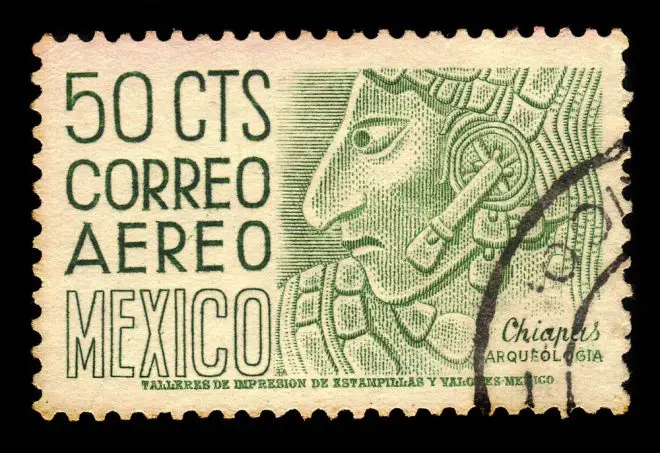
It may seem counterintuitive that you have to pay international prices to ship to Mexico. After all, the United States and Mexico share a border that is nearly 2,000-miles long. However, shipments to Mexico are still considered international and subject to the rules and prices associated with international deliveries.
This article outlines the best carriers for shipments to Mexico, unique shipping requirements, and the postage required for standard postcards, envelopes, and parcels.
Contents
Best Carriers for Mail to Mexico
The United States Postal Service (USPS), Federal Express (FedEx), DHL Worldwide Express, and the United Parcel Service (UPS) all ship to Mexico.
For envelopes and light parcels, USPS is typically the most affordable carrier. USPS transports all envelopes and parcels to the border, where they are given to the Mexican Postal Service, who ultimately delivers them to their final destination. Therefore, while USPS is the most affordable carrier, they are not always the most efficient.
USPS has a maximum parcel weight of 66 pounds and a maximum package girth of 108-inches when shipping to Mexico. If you are sending a parcel that exceeds these limits, DHL tends to be the most affordable option.
If you need your parcel to arrive quickly or in a specific timeframe, UPS or FedEx are the best shipping options. UPS and FedEx both offer definitive delivery days and can guarantee delivery within a particular timeframe for an additional cost.
Given that USPS is the best option for the shipment of most letters and packages, the postage rates in this article reflect USPS prices unless otherwise specified.
Postage to Send Postcards to Mexico
Postcards can be shipped via USPS using international postage rates. To send a postcard to Mexico, you will need $1.30 in postage, which can be covered with one Global First-Class Forever Stamp ($1.30) or three First-Class Forever Stamps ($1.74).
USPS defines postcards as rectangular cards that have dimensions between 3.5 x 5.0 x 0.007 inches and 4.25 x 6.0 x 0.016 inches. Cards that are outside of these dimensions or are not rectangular require additional postage.
Postage to Send Standard Envelopes to Mexico
Envelopes can be sent to Mexico using international postage rates with USPS. To ship an envelope weighing less than two ounces to Mexico, you will need $1.30 in postage. You can use one Global First-Class Forever stamp ($1.30) or three First-Class Forever Stamps ($1.74).
If your envelope weighs more than two ounces, you will need an additional $0.66 in postage for every extra ounce.
USPS defines standard envelopes as envelopes that have dimensions between 3.5 x 5.0 x 0.25 inches and 6.125 x 11.5 x 0.25 inches. If your envelope is rigid or not rectangular, it will be considered non-machinable, meaning that it will need to be hand-sorted. Non-machinable envelopes require an additional $0.21 in postage.
Postage to Send Large Envelopes to Mexico
Large envelopes can be sent to Mexico using international postage rates with USPS. USPS considers large envelopes to have dimensions between 6.125 x 11.5 x 0.25 inches and 12 x 15 x 0.75 inches.
The postage required to mail large envelopes is dependent on the weight of your envelope:
| Weight | Postage Required | Stamps Required |
| 1.0 ounce | $2.60 | 2 Global Forever Stamps ($2.60) or 5 First Class Forever Stamps ($2.90) |
| 2.0 ounces | $3.38 | 3 Global Forever Stamp ($3.90) or 6 First Class Forever Stamps ($3.48) |
| 3.0 ounces | $4.14 | 4 Global Forever Stamp ($5.20) or 8 First Class Forever Stamps ($4.64) |
| 4.0 ounces | $4.92 | 4 Global Forever Stamp ($5.20) or 9 First Class Forever Stamps ($5.22) |
| 5.0 ounces | $5.69 | 5 Global Forever Stamp ($6.50) or 10 First Class Forever Stamps ($5.80) |
| 6.0 ounces | $6.45 | 5 Global Forever Stamp ($6.50) or 12 First Class Forever Stamps ($6.96) |
| 7.0 ounces | $7.23 | 5 Global Forever Stamp ($6.50) or 13 First Class Forever Stamps ($7.54) |
| 8.0 ounces | $7.99 | 7 Global Forever Stamp ($9.10) or 14 First Class Forever Stamps ($8.12) |
| 9.0 ounces | $9.64 | 8 Global Forever Stamp ($10.40) or 17 First Class Forever Stamps ($9.86) |
| 10.0 ounces | $9.64 | 8 Global Forever Stamp ($10.40) or 17 First Class Forever Stamps ($9.86) |
| 11.0 ounces | $9.64 | 8 Global Forever Stamp ($10.40) or 17 First Class Forever Stamps ($9.86) |
| 12.0 ounces | $9.64 | 8 Global Forever Stamp ($10.40) or 17 First Class Forever Stamps ($9.86) |
| 13.0-15.994 ounces | $11.31 | 9 Global Forever Stamp ($11.70) or 20 First Class Forever Stamps ($11.60) |
Visit Where to Buy Stamps to find where to buy stamps near you.
Postage to Send Packages to Mexico
The postage required to send packages to Mexico is based on the size and weight of the parcel. You can calculate the cost of postage for your parcel using the USPS Postage Price Calculator.
To use the USPS Postage Price Calculator, follow these steps:
- Follow the link to the USPS Postage Price Calculator.
- Under the “What’s the destination country” dropdown menu, select “Mexico.”
- Enter the zip codes for your shipping location and destination.
- Next, enter the date and time of when you plan to ship your parcel.
- Select the type of parcel you wish to send.
- A new page will appear with the price for various shipping options in your area.
You can choose the shipping method of your choice based on your desired delivery date. Once you have determined the shipping method you wish to use, you can print a label using the USPS Click-N-Ship.
If you want to avoid the hassle of calculating your package’s size and weight, you can also ship items using USPS Flat Rate boxes. Flat Rate Boxes come in a variety of sizes and can be shipped at a standard rate regardless of the weight of the contents. For more information about the Flat Rate shipping options offered by USPS, visit USPS Priority Mail.
Delivery Times to Mexico
The average delivery time for postcards and First Rate envelopes mailed with USPS First Class Mail International (the standard shipping option used) is 7-21 days. If you mail postcards or envelopes using Priority Mail International instead, the delivery time is shortened to 6-10 days. Priority Mail Express International is the most expensive option for postcards and letters, but it guarantees delivery in 3-5 days.
Package delivery times are dependent on the carrier and the shipping method you choose. Package delivery can also be delayed by customs. Generally, parcels shipped with FedEx, DHL, and UPS standard shipping options take 3-10 days to reach their final destination. Packages shipped with USPS are given to the Mexican Postal Service for transportation and delivery in Mexico; therefore, delivery times are typically closer to 10-14 days.
Addressing Mail to Mexico
Addresses in Mexico are similar to those of the continental United States, with a few notable changes. Addresses should be completed in the following way:
Name of Addressee
Street Address (Street Type, Street Name, House Number)
Neighborhood, Municipality
Postal Code, City, State
Country
Example:
Mr. Smith
Av. Ruiz Cortines 2401
Mitras Nte.
64320 Monterrey, N.L.
Mexico
Additional information regarding each line of the address is discussed below:
Line 1: Name of Addressee
This line should reflect the name of the person or company to whom you are shipping.
Line 2: Street Address
When writing the street address, you want to write the street type, followed by the street name, followed by the street number. If there is an apartment number, it should follow the street number. For example, “Av. Ruiz Cortines 2401 – Piso 3-26” would take the address above and specify a building floor (Piso 3. Piso means floor) and room number (26).
Street directions and street types can be abbreviated following standard Spanish abbreviations. USPS provides a list of Standard Abbreviations for Spanish-Language Addresses.
Line 3: Neighborhood, Municipality
Mexico is divided into 31 states and one federal district (Mexico City). The states are divided into municipalities, which are then divided into neighborhoods. Municipality names can be written out or abbreviated, as in the example above.
Line 4: Postal Code, City, State
This line has one of the biggest differences between Mexican and American addresses. For addresses in Mexico, you want to write the zip code, followed by the city and state- not the other way around. State names can be written out or abbreviated. In the example above, Nuevo León has been abbreviated to N.L.
If you choose to abbreviate state names, it is essential to use approved abbreviations so that your parcel is delivered to the correct location. The Department of Transportation provides an accurate list of State Abbreviations.
Line 5: Country Name
This line represents the country where your parcel’s final destination is located (in this case, you will want to write “Mexico”).
Customs Forms for Shipments to Mexico
Parcels shipped to Mexico require customs forms. If you are shipping with USPS, the customs declarations are incorporated into the label on your parcel, and no additional documentation is required. If shipping with UPS, you can complete your customs forms using the UPS Electronic Data Interchange (EDI). If you are shipping with FedEx, you can complete your customs forms using the FedEx Electronic Trade Documents (ETD).
The customs forms will inquire about the package value. For example, if your package is valued at more than $50, it will be subject to the 16% value-added tax (VAT) on top of the shipping fees. Personal packages valued under $50 do not have to pay additional duties and taxes.
If you are concerned about your customs forms or unsure how to fill them out, employees at USPS, FedEx, DHL, and UPS will happily help you complete the forms and prepare your package for shipment.
Items Prohibited from Import to Mexico
Each country has its own set of rules regarding items prohibited from import or export. Being able to ship an item from the United States does not guarantee that the item will be able to pass through customs and into your destination country. Therefore, it is important to make sure that the items you are shipping are not included on the Mexican prohibited item list.
Some of the most common items that are prohibited for import to Mexico include:
- Ammunition, firing caps, and loaded metal cartridges for portable firearms
- Coins, banknotes, currency notes, and other currency
- Precious stones, jewelry, and other valuable items
- Meat and products derived from pork
- Perishable confectionery, pastries, fruit, and vegetables
- Perishable infectious biological substances
- Pistols or other devices for emitting teargas
- Radioactive materials
- Tickets, lists, and circulars for foreign lotteries
- Works infringing copyrights covering Mexico.
Mexico also restricts the import of chocolate and products made of chocolate, as well as medicinal products, beauty products, cosmetics, and toilet articles.
For a complete list of Mexico’s import prohibitions and restrictions, see USPS’s Mexico Prohibited and Restricted Items list.
For additional information regarding shipments within the United States and internationally, check out postage and shipping information on mystampguide.com.






